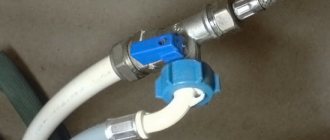We are all accustomed to the fact that modern household appliances will do their job properly and help us around the house, especially with regard to washing, because washing bed linen or any other large item by hand is inconvenient. Therefore, when a washing machine does not wash clothes well, housewives begin to speculate about the reasons behind this.
Naturally, a good technician will determine the exact cause of the breakdown, but not only repairs can correct this situation. Before spending money on calling a technician, watch the washing process of the unit, so some of the reasons for the unsatisfactory performance of the “washing assistant” can be eliminated independently.
The washing machine does not wash well, reasons
If your things and clothes do not become cleaner after washing, but rather become dirtier or worse, become irreparably damaged, then the reason is hidden in the operation of the unit. Naturally, satisfactory results depend on the quality of the powder, bleaches, vanishes and conditioners.
But replacing the detergent does not always correct the situation. There are many reasons why the machine does not wash clothes well, and most often they lie inside the unit, i.e. it is impossible to see them with the naked eye.
Such breakdowns occur at different times, i.e. the performance of the unit either decreases gradually over years of operation, suddenly or immediately after purchase. So, let's look at the main reasons why a washing machine does not wash well and find out whether you can solve this problem yourself.
The machine doesn't wash well
When you find things that are not clean enough after washing, the question usually arises as to why the washing machine does not wash well for no apparent reason. The reasons for poor quality removal of stains and dirt from laundry by a washing machine, provided that it is installed correctly and started for the first time, are presented as follows:
- Water quality. In apartment buildings, water supply to the sanitary areas of apartments is carried out through common pipelines. If one of the neighbors in the “riser” changed pipes or installed equipment, then there is a high probability that rust and sediment “went” lower, getting into the water supply in the machine, therefore, it does not wash things well. The problem is solved by draining to clean water.
- The machine does not wash well due to the washing powder. Purchasing cheap washing powders from unknown brands is one of the reasons for poor quality washing. Excessive foaming can occur when using hand washing powder or significantly exceeding the dosage for one wash, which does not guarantee a quality result. Why sometimes branded powder does not wash well - the possibility of purchasing counterfeit products cannot be ruled out.
- Faulty water heater. Failure of the heating element leads to the fact that the washing machine does not wash well with cold water. If clothing is significantly soiled, it is impossible to obtain the desired result.
- Another reason why the washing machine does not wash well may be a malfunction of the drum drive. It may rotate intermittently or slowly due to critical wear of the bearings or a stretched belt. If these malfunctions are detected, you must stop operating the washing machine immediately and contact the nearest service center for help.
Attention! It is impossible to remove individual stains from clothing without the use of special cleaning compounds by simply washing them in a machine. If the washing machine does not wash things, then you should pre-treat it with a stain remover, and then wash it again.
Detergent
It's no secret that dishwashing detergents, soap or soda are not the number one laundry detergents. We use these substances in order to reduce the pain of heavily soiled clothing by pre-treating the stains with them. That is, it is recommended to wash laundry in a machine together with a good powder intended for automatic washing.
Often, young housewives, due to savings, buy cheap products or stumble upon counterfeits of well-known brands. As a result, the washing machine does not wash well, the laundry remains dirty after the wash cycle or stains of undissolved detergent appear on it.
Water
Surely you know that tap water contains various metal salts that determine its hardness. Because of this, things are often washed unsatisfactorily, since the hardness of the water prevents the powder from foaming. As a result, the housewife remains dissatisfied, changes detergents and may even seek help from a specialist.
If the reason why the washing machine does not wash things well lies in the water, then it is necessary to use various softeners when adding powder. Sometimes it is enough to add ordinary soda to make the water softer. Also, problems with washing can be caused not only by poor washing out of the powder, but also by the appearance of yellow spots that were not there before washing.
This situation occurs rarely, but is still possible. The laundry turns yellow or rust-colored dirt appears if, when the machine was drawing water, the liquid itself was dirty, rusty water began to flow, and the built-in filters did not cope with the task.
Bad water or poor quality powder
The problem of hard water containing impurities is very relevant for urban residents. Many housewives complain that they seem to wash with a good detergent, even with bleaching ingredients, but over time a gray, dull coating appears on white clothes. This is lime, which after each wash remains a little in the fibers of the fabric. Moreover, such sediment accumulates in the hoses, in the body, and on some parts of the washing machine. To get rid of it, firstly, when washing, it is advisable to use special water softening agents, such as Calgon, and secondly, you can clean the machine with citric acid or vinegar. Watch a detailed video on this topic on the YouTube channel.
The water may also be dirty due to old, rusty pipes in the water supply system, which have long required replacement with new ones. In this case, it is necessary to install special filters for washing machines, which are designed to clean the water before it enters the machine.
Problem No. 2 is a low-quality laundry detergent. We all want to save money and we know that powders can be very expensive. By purchasing a cheap product, we are unable to wash our clothes, and we are also ruining our machine, since such powders can mix whatever you want. Subsequently, scale, limescale and, worst of all, equipment breakdown.
Tip: to be sure that your detergent is of poor quality, wash it a couple of times using a different washing powder. If the washing result completely satisfies you, then the problem has been identified. By the way, capsules with washing gel are a good replacement for powders. This gel washes well and rinses well from fabric. As a result, no streaks or whitish spots on your things.
Features of the technology
The reason why a washing machine does not wash well is not always eliminated by changing detergents, softening the water, or even calling a technician. A large assortment of household appliances allows people to buy small-sized machines that not only take up little space, but also use water sparingly.
If your machine does not work as it should, does not wash the laundry and traces of powder remain on it, then the reason lies in the features of the unit itself. If it does not cope with the function assigned to it, then you probably chose the wrong mode or simply loaded the drum with clothes more than 90%. Due to overload, small washing aids often break down and, at best, are not able to rinse the fabric as needed.
The machine does not spin clothes after washing
If the wrong mode is selected, the washing machine (even as powerful as the LG FH0B8WD7) will not wring out things. It is only necessary to run an additional spin after the cycle. Or stop the program and select one that involves subsequent spinning of the laundry.
The second natural reason is too low revs. If the user has programmed the equipment to the minimum, the laundry will remain damp, and it will seem that the washer did not spin it.
But most of the reasons why washing equipment does not spin are caused by malfunctions of the “internals” of the device:
Overload and lack of balance
The problem arises if the equipment does not have a sensor to detect imbalance. When there is too much content in the drum or the item is heavy (the recommended loading weight is exceeded), it simply cannot spin. The solution to this problem is simple - take out half the laundry, distribute the rest more evenly throughout the drum and try again.
Uneven distribution of laundry
This reason is similar to the first, but occurs when the user loads too many clothes with long legs/sleeves. During washing, it gathers into one large lump that cannot be wrung out properly. You will need to drain the water, and then spread the contents of the drum evenly and start the spin cycle again.
Useful: The Indesit IWSB 61051 C ECO EU has an auto option that controls balancing - things are distributed as expected, automatically. Even trousers and sweaters.
The filter or drain valve does not work
Water does not leave the tank at the right time, which blocks the spin cycle. The reason is a clogged drain filter. It is located at the bottom of the washing machine behind the removable panel or lid. The exact location of the component is indicated in the instructions for the specific model.
The part intended for filtration must be checked for the presence of foreign objects and cleaned. To do this, disconnect the washing machine from the network, place a bowl under the filter to collect water and carefully remove it. If the valve is dirty, you will need to clean the tube and/or pipe.
Important: The filtration part most often becomes clogged if the user forgets to check the pockets before loading into the drum, and store receipts, coins and other small items remain in them. They end up in the drain hose and then into the filter.
Damage to the tachometer
This is a device responsible for controlling the number of revolutions depending on the selected program and the weight of the loaded laundry. The tachometer fails due to frequent overloads, loose fastenings, faulty contacts and wiring. A loose fastening can be “tightened”; it is better to entrust the solution to the wiring problem to a specialist, but if the problem is directly in the tachometer, then it will have to be changed.
Control module malfunction
The control panel, which is programmed to perform functions that have separate settings for a specific operating mode, stops sending commands to the drum. This is not the case when you should try to “reanimate” the equipment yourself.
Engine malfunction
A common problem during long-term use. The malfunction occurs both in the engine hardware and in the “brushes”, which wear out over time. The “brushes” must be replaced, but to do this you will have to disassemble the body of the washer (for example, on the Bosch WAW32640EU, the manufacturer produces components for several years after the equipment is discontinued). If you want to play it safe, you should entrust the matter to a repairman.
Machine operating mode
If the washing assistant does not remove stains well, then make sure that the program used for washing corresponds to the type of fabric and the recommendations left by the clothing manufacturer on the label. Often the washing machine does not cope with the function assigned to it, because the selected mode is not intended for the clothes that were immersed in the drum.
As you know, synthetic and delicate fabrics such as silk and wool cannot withstand high temperatures, and it is almost impossible to remove stains from cotton without boiling. Thus, if you do not wash in a special mode, then it is pointless to wonder why the washing machine does not wash away stains on clothes well.
If you load a cotton T-shirt with a stubborn, old stain into the drum, but set the washing program to a temperature no higher than 30-40 degrees, then the stain will remain on your item.
Therefore, in order not to overwash your clothes and not damage the machine itself, choose a program that corresponds to the information on the tag, sort the laundry correctly and do not overload the machine.
Various breakdowns
Above we discussed the reasons not related to mechanical damage to the machine. Based on this, powder, mold and water can be easily eliminated on your own. If the washing machine begins to wash poorly due to a breakdown of some unit that rotates the drum during the program or spins, then the result of the device will clearly not correspond to the required one.
Only a specialist can fix such malfunctions, and you can only assume what exactly caused the unsatisfactory operation of the unit.
- The heating element burned out, causing the program to wash in cold water . Anyone knows that it is almost impossible to remove dirt with cold water, let alone a machine that did not wash well due to a failure of the temperature sensor or the heating element itself.
- The bearings have failed, and the drum makes sounds unusual during normal operation during rotation. Due to this problem, the unit is not able to spin things properly and the quality of work will be poor.
- The belt is torn or worn . This is another reason why the unit does not cope with its task, since the drum does not make the required revolutions.
- Is it possible to wash a coat in a washing machine?
- How to wash linen in a washing machine
Major breakdowns
Rinse or spin mode does not turn on
Before rinsing, the machine stops, starts draining water and displays an error. There are 2 LEDs blinking on the panel: above the button with the image of a clock and with the “lock” icon.
Error code F08 means the relay for turning on the heating element is stuck, a signal if there is emptying. Or the pressure switch is stuck in the “filling” position.
To resolve this error, you should check:
- pins of connector J3 on the board
- state of the reset switch by ringing it on the connectors
- wires connecting the transfer switch to J3 connectors
- the need to replace the pressure switch, control board or heating element
Most often, such an error code signals a damaged heating element, the main heating element. This part is easy to replace yourself and is accessible through the rear panel.
Interesting to know! You can check the heating element using a megohmmeter - place one probe on the terminal of the heating element, and the other on its body. If the megohmmeter shows any value, then the heating element is broken and must be replaced.
Water leakage
The presence of a leak indicates a hole in the rubber cuff sealing the hatch. If the cuff is not damaged, but water is leaking, you should clean the lower part of the door glass from the inside.
During operation, dirt accumulates in this place, worsening the contact between the glass and the rubber seal. To eliminate this problem, simply wipe the glass with a cotton swab dipped in nail polish remover.
Washing machines of the Wisl series provide additional protection for the housing against leaks.
The washing machine does not turn on
If the washing machine does not respond when you press the power button, you need to check the serviceability of the socket.
Disconnect the cord plug from the outlet and plug in any other electrical device, for example, a table lamp. If the outlet is working properly, you need to visually inspect the power cord for damage.
Attention! To avoid fires, it is prohibited to connect the machine to the network via an extension cord, or to use adapters or double sockets.
A complete failure of the machine to operate may indicate a malfunction of the electronic control module and requires specialist intervention.
If the machine turns on but does not start the washing program, you need to check that the door is closed tightly.
Various blockages
Blockages in the drain system are considered one of the main problems with Indesit washing machines. If the drain hose and filter are clogged, the machine stops draining water. If the model is equipped with a display, error code F05 is displayed on it.
Cleaning the filters yourself is not difficult even for those who do not have the skills to handle equipment. To clear the blockage, you need to open the bottom door on the front panel, lay rags on the floor or place a flat tray and pull out the catch filter, rotating it counterclockwise.
Garbage and small objects (coins, buttons, pins) accumulate here. After cleaning the filter, the unit is ready for use. This procedure is recommended to be done once every few months as a preventative measure.
Failure of parts
The Italian brand Indesit complies with European technical standards. Washing machines of this brand have vulnerabilities that you should pay attention to when operating and repairing the devices.
The following parts are subject to frequent breakdowns:
- Surge filter - can withstand operation for up to 4 years, often defective
- Heating element (tubular heating element) - made of stainless steel without coating, which leads to rapid scale fouling
- Electric motor parts - capacitors, trim and tachogenerator sensor
- Depressurization of the door seal
Experts consider replacing bearings to be difficult to repair due to the tank being welded tightly. Often, owners of the Indesit Wisl automatic machine contact the service due to blockages in the drain system.
Breakdowns occur due to improper connection of equipment, careless handling of the machine, or as a result of natural wear and tear.
Bearings
A special feature of the Indesit washing machine is its lightweight, sealed tank. This is the weak point of the unit, due to which bearings often break. The design of the tank does not allow you to disassemble it yourself; it is better to contact a workshop where the tank will be completely replaced. This is an expensive operation, so sometimes it is cheaper to purchase a new device.
A number of Indesit models produced in Italy, Turkey and some other countries provide the ability to replace bearings. Only a qualified technician can determine whether the device can be repaired.
Control module
The electronic control module in Wisl series machines is highly reliable. It is equipped with an automatic protection system that is triggered if the operating requirements of the machine are not met.
The control module of the Indesit washing machine is sensitive to air humidity, drops of water entering the system or voltage drops.
In order to “please” the electronics, you should strictly follow the instructions included with the device.
If a module error code is displayed on the panel, you need to check:
- condensation on current-carrying circuits
- reliability of contact fastening
- presence of oxidations
- no blockages in the drain hose and filter
- accumulation of dirt on components and parts.
After eliminating inconsistencies with the program requirements, the machine can be restarted - many models support starting the cycle from the middle.
Attention! If the warranty period has not passed, the service center will fix the problem in the module free of charge. In other cases, the repair of the control unit of the Indesit machine should be entrusted to a professional workshop.
Electric motor
A commutator type electric motor is installed here.
The most common problems:
- Brushing of brushes. Occurs if you use the device too often. When starting the program, it does not start working, which indicates a breakdown of the main motor brushes. The parts are paired and must be replaced at the same time for correct operation of the motor.
- Peeling of lamellas on the collector. The lamellas peel off most often in old devices when the brushes rub them into holes.
- Break or interturn short circuit in the rotor and stator windings. If there are any signs of winding burning, the motor must be completely replaced.
Electric motor failure is also determined by the lack of rinsing and spinning. If the washing machine heats the water and washes, but when moving to the final modes the engine starts to turn idle, this means that the engine is broken and must be replaced.
Shock absorber and dampers
The shock absorber is an elongated device, inside of which there is a piston with a return spring. They serve to reduce drum vibrations.
Dampers are devices similar to shock absorbers, they differ in the absence of a return spring. Dampers are installed in new models of washing machines.
If the tank knocks during washing and vibrates with a hum, it is worth checking the condition of the shock absorbers. The lack of lubrication in them is indicated by the characteristic creaking and tight rotation of the drum.
Attention! If the shock absorber or damper breaks down, further operation of the washing machine is prohibited.
Some washing machine owners save on parts by replacing the rubber insert in the old shock absorber. This method does not guarantee correct operation of the device; it is better to purchase a new working shock absorber.
water pump
The pump is part of the drainage system of the washing machine and performs the important function of pumping water out of the tank. This part experiences the greatest loads and can quickly fail. You can determine if the pump is faulty by hearing.
Signs of pump failure:
- When draining water, the pump makes a loud noise, but no water flows into the tank.
- Pump doesn't work
Before changing the pump, you should make sure the drainage system is clean. Inspect and, if necessary, clean the drain filter, hose and drain pump impeller. Find out if there are any foreign objects in the system.
If the above measures do not help, the pump must be replaced.
Water supply problem
If problems arise with the water supply, you need to check the presence of pressure in the tap, and then inspect the inlet hose and its filter.
The washing machine does not fill with water well
If the pump does not fill the tank with water, this may indicate a clogged filter in the fill valve. You should turn the unit away from the wall and unscrew the drain hose from the rear panel. Using pliers, pull out the fill valve filter and then rinse it well under running hot water. If necessary, clean with a brush.
The washing machine does not fill with water
If the washing machine does not fill with water, you need to check:
- connecting the inlet hose to the tap
- hose for kinks and kinks
- tap water pressure
- water supply tap open/closed
- pressing the "Start" button
If you suspect a blockage, you need to turn off the water supply to the washing machine, unscrew the inlet hose, direct it into the basin and resume the water supply. This will allow you to rinse it free of debris.
It is recommended to check the inlet hose at least once a year and replace it immediately if there is any suspicion of a leak. Do not install used hoses.
Worth remembering! While the machine is operating, the inlet hose is under water pressure and can burst if it malfunctions.
The supply of washing powder is interrupted
If the powder does not pass through the washing machine, and water flows out of the tray where it is poured, this indicates a blockage.
To solve the problem, carefully pour a small amount of boiling water into the tray. A similar problem occurs when using poor quality washing powder or too low pressure in the pipe that connects the tray and the tank of the machine.
As a result, a dense powder plug is formed, which prevents water from entering the tank. Periodically it is worth rinsing the cuvette itself under running water.









